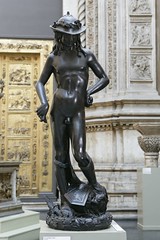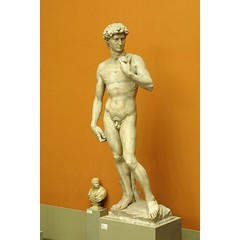By Stuart Frost
February is Lesbian, Gay, Bisexual and Transgender (LGBT) month so many museums have planned events to coincide with it. This set me thinking about connections with the medieval and Renaissance period and our plans for the new galleries. A cast of Donatello’s David was the focus of a gallery talk by one of my colleagues at this time last year. The original is in Florence, so this talk took place around a nineteenth century plaster-cast in the Cast Courts. The original nude figure was displayed in several different locations, and each change influenced the way the statue would have been understood. 
The sensual nature of Donatello’s David has often been commented upon. His youthful David has battled Goliath without armour, shielded by his faith. It is likely that the nakedness of the figure would have connected with the fifteenth century viewer in several other ways. For example, the statue was made a time when there was renewed interest in the art of ancient Rome, a culture where the male nude was commonly depicted in sculpture. At the time Donatello’s David was made the nakedness of the figure was strikingly different and new. The statue raises questions about ideals of male beauty in Renaissance Florence.
It is clear that same-sex desire was for many male Florentines a part of every-day life in the fifteenth and sixteenth centuries. Surviving legal records prove that a high proportion of Florentine men in the fifteenth century came before the authorities on charges of what was then called ‘sodomy’. Michael Rocke has written extensively about this and used the documentary evidence to explore the nature of male same sex relationships. Sexual relationships between males were illegal, and repeated convictions in Florence sometimes led to a death sentence.
 Museums and galleries have tended not to discuss these aspects of Renaissance culture in the past. This has begun to change. There are often more connections that people may suppose. More museums are beginning to identify objects in their collections that have a connection with LGBT history, making the information available online, or running study days and events to highlight histories that have often been ignored or overlooked.
Museums and galleries have tended not to discuss these aspects of Renaissance culture in the past. This has begun to change. There are often more connections that people may suppose. More museums are beginning to identify objects in their collections that have a connection with LGBT history, making the information available online, or running study days and events to highlight histories that have often been ignored or overlooked.
The British Museum’s exhibition about Michelangelo’s drawings last year was one of the first where the culture of sexual relationships between males in Renaissance Florence was addressed. Michelangelo’s sexuality was also something that was discussed is several of the exhibition reviews at the time. Some reviewers focussed on whether Michelangelo’s sexuality was reflected in his depictions of the male body, or whether he was gay in the modern sense of the term. Inevitably opinions varied. Michelangelo’s work is also represented at the V&A, most prominently in the Cast Courts. His David, depicted to the right, is of course very different to Donatello’s for many reasons.
The V&A has recently programmed a series of gallery talks to coincide with LGBT month. The talks are taking place at the V&A on Saturday 9th February. Unfortunately the Italian Cast Court is currently closed which means that neither Michelangelo’s or Donatello’s David can be included this year. The way that both sculptures have become a focus for discussion related to sexuality and same-sex desire would have made a fascinating talk.